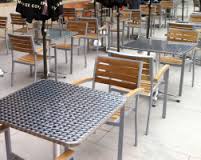
“Stainless” was an early designation for this steel when first used for manufacturing cutlery. Soon becoming a generic name for these steels, it now covers a wide range of steel types and grades of corrosion and oxidation resistant materials.
Stainless steels are iron alloys with a minimum of 10.5% chromium. Other alloying elements, such as Nickel, Molybdenum, Titanium, and Copper, are added to enhance stainless steel’s strength and durability.
Its resistance to corrosion and staining, low maintenance, and familiar luster make it an ideal material for outdoor furniture. With proper care, maintenance, and placement, stainless steel offers durability and style. Over the total life of a product, stainless steel often offers the best value.
Stainless steel is good for the environment because it is 100% recyclable and does not need additional finishing to achieve corrosion resistance; nor does it need harsh chemicals to keep it clean. In fact, over 60% of new stainless steel comes from old re-melted scrap.
Care and Maintenance
As with any item left permanently outside, stainless steel outdoor furniture requires regular maintenance to keep it looking like new. Routine cleaning of stainless steel should be done with a non-abrasive cloth and clean, warm water, with or without a gentle detergent. Always wipe with the directional grain of the steel, not across it. After washing, rinse with fresh water and dry thoroughly.
For fingerprints or smudges, you can use a stainless steel cleaner. Always read the manufacturer’s instructions carefully before applying a stainless steel cleaning product. If more aggressive cleaning is required, the type of contaminant needs to be determined and an appropriate cleaner chosen that is safe for stainless steel.
Although stainless steel is generally resistant to corrosion, salt water and air, chlorinated water from a swimming pool, and other chemicals may cause discoloration of the surface, resulting in small brown spots. These spots do not affect the strength, integrity or longevity of the furniture; they are simply superficial discolorations that require cleaning by gently rubbing the surface, in the direction of the brushed finish, with a Scotch-Brite® pad. If these deposits are allowed to build up, it may be necessary to clean the product with a stainless steel cleaner polisher, which cleans and restores the look of stainless steel furniture and makes the surface repellent to both dirt and water.
Never use bleach, cleaners containing chlorine, or abrasive cleaners (steel wool pads or highly abrasive cloths) on stainless steel. Some of the fine particles can lodge in the surface of the steel and eventually rust, giving the appearance that the steel itself is rusting.
Call us at 610-674-3122 to speak with one of our experts to guide you through the options for tables, sizes, dimensions, chairs, and barstools or click Outdoor Restaurant Seating.

